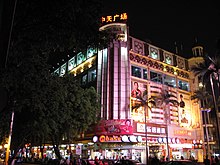Shiqiqu Subdistrict
Shiqi was historically spelled Shekki in English, and is nicknamed Tiecheng (鐵城; Tiěchéng; 'Iron City').
Local people mainly speak the Shiqi dialect, a Yue dialect related to Standard Cantonese.
Geography
The subdistrict is located at the foot of Yandun Mountain (烟墩山). The Qi River (Chinese: 岐江; pinyin: Qí Jiāng) is the primary river in the subdistrict.
Administrative subdivisions
As of 2020, Shiqi has administrative jurisdiction over the following 19 residential communities (Chinese: 社区):
| Name | Hanzi | Pinyin |
|---|---|---|
| Guiyuan Community | 桂园社区 | Guìyuán Shèqū |
| Minzu Community | 民族社区 | Mínzú Shèqū |
| Taiping Community | 太平社区 | Tàipíng Shèqū |
| Lianxin Community | 莲新社区 | Liánxīn Shèqū |
| Yingyang Community | 迎阳社区 | Yíngyáng Shèqū |
| Xianhu Community | 仙湖社区 | Xiānhú Shèqū |
| Hubin Community | 湖滨社区 | Húbīn Shèqū |
| Yuelainan Community | 悦来南社区 | Yuèláinán Shèqū |
| Fengming Community | 凤鸣社区 | Fèngmíng Shèqū |
| Dongming Community | 东明社区 | Dōngmíng Shèqū |
| Bo'ai Community | 博爱社区 | Bó'ài Shèqū |
| Minquan Community | 民权社区 | Mínquán Shèqū |
| Minsheng Community | 民生社区 | Mínshēng Shèqū |
| Hongji Community | 宏基社区 | Hóngjī Shèqū |
| Lianyuan Community | 莲员社区 | Liányuán Shèqū |
| Kanghua Community | 康华社区 | Kānghuá Shèqū |
| Daxin Community | 大信社区 | Dàxìn Shèqū |
| Lianxing Community | 莲兴社区 | Liánxìng Shèqū |
| Donggangwan Community | 东港湾社区 | Dōnggǎngwān Shèqū |
Demographics
The subdistrict has a permanent population of about 227,200.
As of 2006, Shiqi Subdistrict had a permanent population of 169,400 and migrant population of 40,900.
Economy

In recent years, Shiqi Subdistrict has attracted a number of national firms involves with financial and information services. The subdistrict is also home to a nationally-significant industrial park, the Guangdong Zhongshan Industrial Park.
In 2019, the subdistrict's gross domestic product grew 1.4%. As of 2019, retail sales in the subdistrict totaled ¥31.164 billion, tax revenue in the subdistrict totaled ¥4.534 billion, and foreign trade in the subdistrict totaled ¥17.695 billion. Shiqi's retail sales ranks first among township-level divisions in Zhongshan.
Statistics from 2006 report that the subdistrict hosts 11,767 unique enterprises.
Education
The Zhongshan Institute of the University of Electronic Science and Technology of China is located in Shiqi Subdistrict.
Transportation
Located in the Pearl River Delta, Shiqi Subdistrict lies in close proximity to a number of major cities. The subdistrict is 40 kilometres (25 mi) south of Guangzhou, and 57 kilometres (35 mi) north of Macau.
Road
Both National Highway 105 and the Beijing-Zhuhai Expressway pass through the western parts of Shiqi Subdistrict.
Shiqi Subdistrict is currently served by the following bus lines operated by the Zhongshan Public Transportation Group Co.:
| Bus Number | Start End | Time |
|---|---|---|
| 006 | Zhongshan Bus Terminal - Changjiang Aquatic Park | 06:20–22:00 |
| 015 | Shongshan North Railway Station - Malin | 06:40–19:00 |
| 050 | Bo'ai Hospital - Aoyuan | 06:30–22:00 |
| 061 | Shongshan Railway Station - Sun City | 06:30–21:30 |
Rail

The subdistrict is served by the Zhongshan North railway station, located on the Guangzhou–Zhuhai intercity railway.
The station is located on Minke West Road (Chinese: 民科西路) in Shiqi Subistrict. It is the station nearest to the city centre of Zhongshan.
Water
Shiqi Subdistrict is located just over 10 kilometres (6.2 mi) west of Zhongshan Port.
Tourist sites

- Tiecheng East Gate City Wall Ruins
- Yueshan Park (Chinese: 月山公园)
- Sanshan Ancient Temple (Chinese: 三山古庙)
- Baiyi Ancient Temple (Chinese: 白衣古寺)
- Xishan Temple
Notable people
- Huang Zuo, Ming dynasty politician and scholar
- Xiao Youmei, composer
- Lü Wencheng, composer
See also
Other subdistricts of Zhongshan
- Dongqu Subdistrict
- Nanqu Subdistrict
- Xiqu Subdistrict
- Torch Hi-tech Industrial Development District
- Wuguishan District
Others
References
- ^ https://stats.zs.gov.cn/zwgk/tjxx/tjnj/content/post_1937766.html
- ^ "Shiqi District". Zhongshan Municipal People's Government. Archived from the original on 3 March 2016. Retrieved 6 February 2021.
- ^ https://stats.zs.gov.cn/zwgk/tjxx/tjnj/content/post_1937766.html
- ^ 行政区域 [Administrative Regions] (in Chinese). Zhongshan Municipal People's Government. Archived from the original on 6 February 2021. Retrieved 6 February 2021.
- ^ 2020年统计用区划代码和城乡划分代码(石岐街道) [2020 Statistical Division Codes and Urban-rural Division Codes (Shiqi Subdistrict)] (in Chinese). National Bureau of Statistics of China. 2020. Archived from the original on 14 December 2020. Retrieved 6 February 2021.
- ^ Theodore Shabad (1956). China's Changing Map: A Political and Economic Geography of the Chinese People's Republic. New York: Frederick A. Praeger. p. 166. LCCN 55-11530. OCLC 916993074.
With the exception of Shiukwan on the Canton-Hankow railroad, Kwangtung's regional centers are situated along the coast, notably in the Canton delta. There, in addition to Canton, are the cities of Fatshan, Kongmoon and Shekki. The metropolis of western Kwangtung is Tsamkong, and Pakhoi is the chief town of the western panhandle.
- ^ 〈大灣區中山石岐,為什麼叫鐵城?〉 天天要聞. 13 November 2021. (in Chinese)
- ^ "(方言文化)合奏一曲方言交响乐". Nanfang Daily. 17 November 2005. Archived from the original on 30 September 2007. Retrieved 22 May 2007. (in Chinese)
- ^ Zhongshan Public Transportation accessed 16 June 2014
- ^ Zhongshan Bus Lines accessed 16 June 2014
